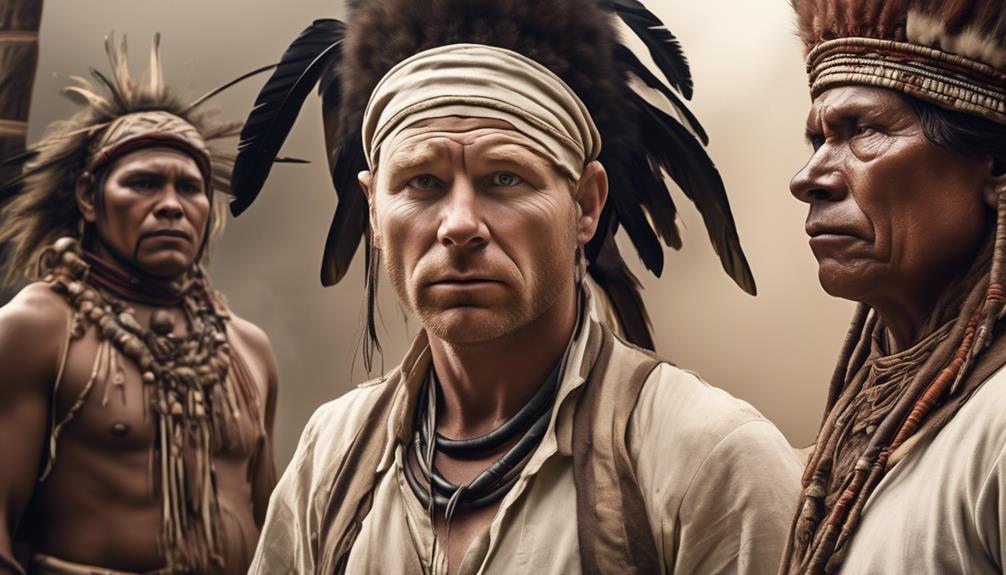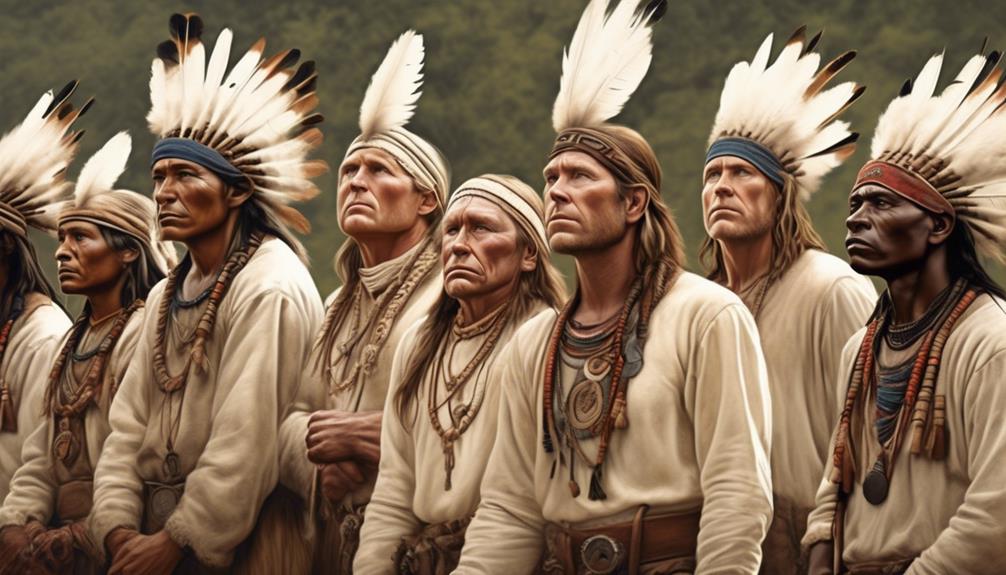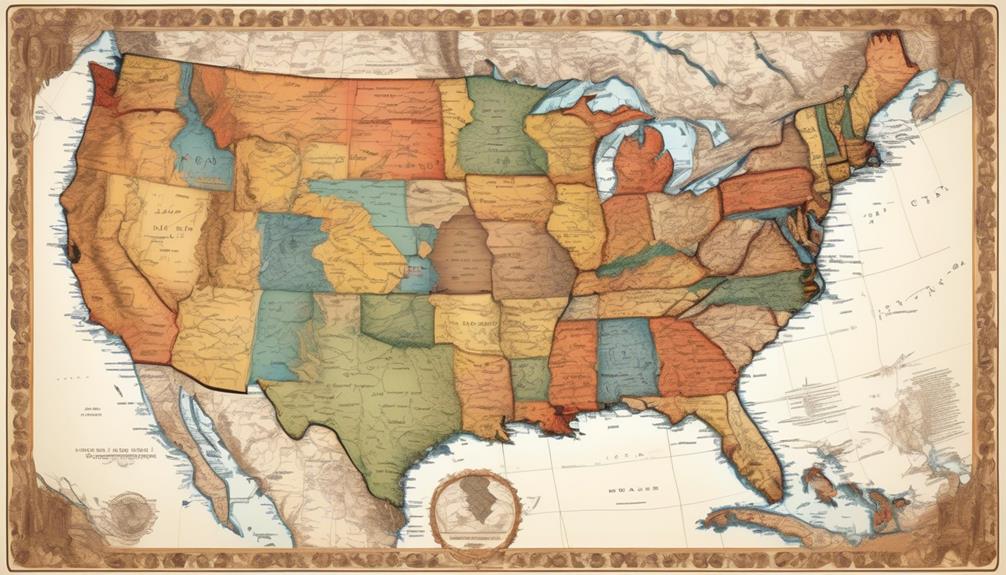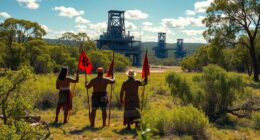Let’s talk about the perspectives of indigenous peoples as seen by white male colonists. While there is a common belief that history is typically told by the victors, what about the opinions of the defeated?
The quotation we're about to explore sheds light on the sentiments of the colonizers towards the indigenous communities, offering a glimpse into the complex and often troubling dynamics that shaped early colonial interactions.
But how did these sentiments influence the treatment of indigenous peoples, and what lasting impact did they have? Join us as we uncover the layers of historical attitudes and their far-reaching consequences.
Key Takeaways
- White male colonists viewed indigenous peoples as obstacles to be removed.
- Colonists believed that indigenous peoples were inferior and in need of assimilation.
- The language used by colonists reinforced their perceived cultural superiority.
- Indigenous communities were oppressed, marginalized, and exploited by colonists.
Historical Context of Colonization
During the age of European colonization, indigenous peoples across the globe were profoundly impacted by the expansion of white male colonists into their territories. The historical context of colonization reveals the complex interactions between indigenous cultures and the colonists, characterized by cultural assimilation and land displacement. Colonists often viewed indigenous peoples as obstacles to be removed in their pursuit of resources and territorial expansion. This perspective led to the systematic displacement of indigenous communities from their ancestral lands, resulting in immense social and economic upheaval.
Cultural assimilation was a common strategy employed by white male colonists, aiming to impose their own cultural norms and practices onto indigenous societies. This often involved the suppression of indigenous languages, traditions, and belief systems, further marginalizing native populations. The imposition of colonial laws and governance further eroded the autonomy of indigenous communities, perpetuating a cycle of subjugation and exploitation.
The historical context of colonization underscores the enduring impact of white male colonists on indigenous peoples, shaping the course of their history and perpetuating deep-seated inequalities that continue to resonate in contemporary societies.
Quotation Analysis and Interpretation

The impact of white male colonization on indigenous peoples' cultural assimilation and displacement lays the foundation for a comprehensive analysis and interpretation of relevant quotations. When examining the quotations in question, it becomes evident that the colonial mindset of white male colonists was deeply rooted in a sense of cultural superiority.
This mindset led them to view indigenous peoples as inferior and in need of assimilation into their own supposedly superior culture. The quotations often reflect a dehumanizing perspective, portraying indigenous peoples as obstacles to be overcome or as exotic curiosities to be observed.
The language used in these quotations reinforces the idea of the colonists' perceived cultural and racial superiority, perpetuating a damaging and one-sided power dynamic. It's important to recognize the insidious nature of this colonial mindset, as it not only influenced the colonists' attitudes and behaviors towards indigenous peoples, but also had lasting effects on the cultural, social, and political landscape of the affected regions.
Power Dynamics and Control
Examining the historical interactions between white male colonists and indigenous peoples reveals a complex web of power dynamics and control, shaped by the colonists' sense of cultural superiority and their imposition of authority over the indigenous communities. The dominance of white male colonists was evident in the systematic oppression and subjugation of indigenous peoples.
The colonists utilized their perceived superiority to exploit and marginalize the indigenous communities, thereby consolidating their control over land, resources, and governance.
The power dynamics were characterized by the imposition of colonial rule, which often led to the disenfranchisement of indigenous populations. White male colonists established systems that institutionalized their dominance and suppressed the autonomy of indigenous societies. This subjugation was reinforced through policies that restricted the rights of indigenous peoples and reinforced the economic exploitation of their labor and resources.
Furthermore, the control exerted by the colonists extended beyond physical dominance and encompassed cultural and social spheres. Indigenous traditions, languages, and belief systems were systematically undermined, further consolidating the colonists' power and eroding the autonomy of indigenous communities. This control over cultural expression and identity reinforced the colonists' position of authority and perpetuated the marginalization of indigenous peoples.
Prejudice and Stereotypes

Analyzing the historical interactions between white male colonists and indigenous peoples unveils a web of entrenched prejudices and damaging stereotypes that shaped the colonists' perceptions and treatment of indigenous communities. These stereotypical beliefs and discriminatory attitudes were deeply ingrained in the colonists' worldview and significantly influenced their behavior toward indigenous peoples.
| Stereotypical Beliefs | Discriminatory Attitudes |
|---|---|
| Indigenous peoples as uncivilized and savage | Justification for forced assimilation and conversion to Christianity |
| Indigenous peoples as inferior and primitive | Rationalization for land seizure and displacement |
| Indigenous peoples as exotic and mystical | Exploitation of indigenous cultures for entertainment and profit |
The colonists' stereotypical beliefs led to discriminatory attitudes that perpetuated the dehumanization and marginalization of indigenous peoples. These prejudices not only justified the colonists' oppressive actions but also contributed to the erasure of indigenous cultures and traditions. Understanding the impact of these prejudices is crucial in comprehending the enduring legacy of colonialism and its ongoing effects on indigenous communities.
Impact on Indigenous Communities
Delving into the historical repercussions of white male colonists' prejudiced attitudes and discriminatory actions uncovers a multifaceted impact on indigenous communities, permeating through social, cultural, and economic dimensions.
Cultural assimilation, a key aspect of this impact, resulted in the erosion of indigenous traditions, languages, and belief systems. The imposition of the colonists' culture and values marginalized indigenous cultures, leading to a loss of identity and heritage. This process of cultural assimilation also disrupted the social fabric within indigenous communities, contributing to internal strife and a sense of alienation.
Moreover, land dispossession had devastating effects on indigenous communities, disrupting their traditional ways of life and economic systems. The seizure of ancestral lands deprived indigenous peoples of their primary means of sustenance and spiritual connection. This loss of territory not only led to economic hardships but also severed the deep-rooted relationship between indigenous communities and their lands, causing profound psychological and emotional distress.
Frequently Asked Questions
What Were the Specific Economic and Political Motivations Behind the Colonization of Indigenous Lands by White Male Colonists?
Economic motivations drove us to seek new resources and trading opportunities in indigenous lands. The desire for wealth and power propelled us to expand our territory and gain control over valuable commodities.
Politically, we aimed to establish dominance and expand our influence through colonization. Our actions were driven by a quest for economic gain and political advantage, leading us to exploit and displace indigenous peoples for our own benefit.
How Did the Attitudes and Actions of White Male Colonists Towards Indigenous Peoples Contribute to the Broader Systems of Colonialism and Imperialism?
Attitudes and actions of white male colonists towards indigenous peoples had a profound impact on power dynamics within the broader systems of colonialism and imperialism.
Their paternalistic attitudes often masked the exploitation of indigenous peoples for economic gain. This contributed to the reinforcement of colonial structures that oppressed and marginalized indigenous communities, perpetuating a legacy of inequality.
The attitudes of the colonists towards indigenous peoples played a pivotal role in shaping the power dynamics of colonial societies.
What Were the Long-Term Effects of Colonization on the Traditional Cultures and Ways of Life of Indigenous Peoples?
Long-term effects of colonization on indigenous communities include the erosion of traditional cultures and ways of life. Impact on cultural preservation has been significant, with many indigenous practices and beliefs being marginalized or lost. This has led to a disconnection from ancestral knowledge and values.
The consequences of colonization are still felt today, as efforts to revive and protect indigenous cultures continue amidst ongoing challenges.
How Did the Power Dynamics Between White Male Colonists and Indigenous Peoples Impact the Legal and Social Structures of Colonial Societies?
Power dynamics between white male colonists and indigenous peoples significantly impacted the legal and social structures of colonial societies. The colonists, driven by economic motivations, established legal frameworks that favored their interests, often disenfranchising and marginalizing indigenous communities.
Social structures reflected this power imbalance, with indigenous peoples facing discrimination and limited rights. These dynamics shaped colonial societies, perpetuating inequality and reinforcing the dominance of the colonists.
What Role Did Religion and Ideology Play in Shaping the Prejudices and Stereotypes Held by White Male Colonists Towards Indigenous Peoples?
Religious influence and ideological beliefs significantly shaped the prejudices and stereotypes of white male colonists towards indigenous peoples. These factors fueled a sense of superiority and justification for the colonization efforts.
The colonists' religious convictions and ideological frameworks often led to the dehumanization and demonization of indigenous peoples, further solidifying their discriminatory attitudes.
This mindset influenced social, legal, and political structures, perpetuating the power imbalances and injustices experienced by indigenous communities.
Conclusion
In conclusion, we've seen how the white male colonists viewed indigenous peoples as inferior and primitive, using their power to control and oppress them. Their prejudice and stereotypes had a lasting impact on indigenous communities, leading to displacement, loss of culture, and violence.
It's clear that the colonists' attitudes towards indigenous peoples were rooted in a deep-seated sense of superiority and entitlement, perpetuating a legacy of injustice and inequality that continues to affect indigenous peoples today.









